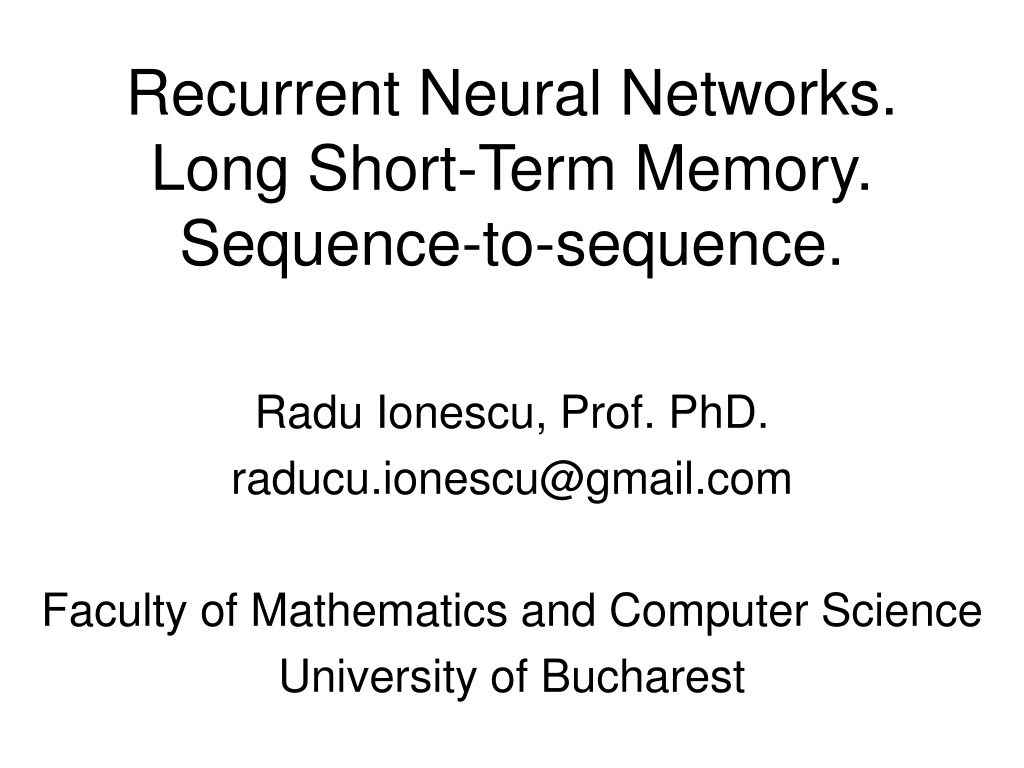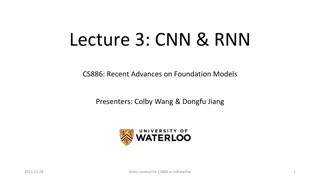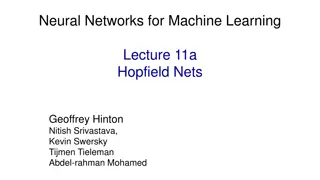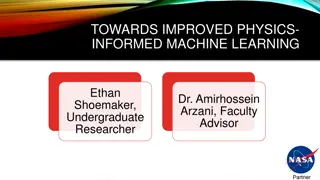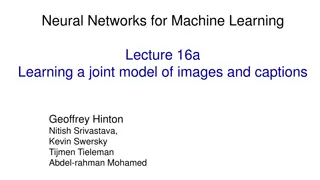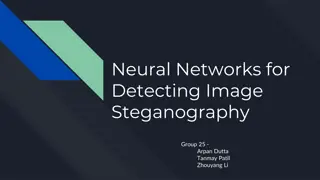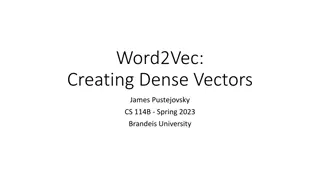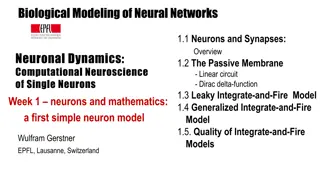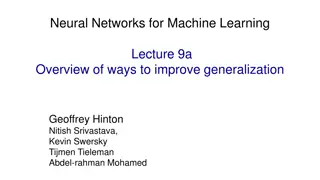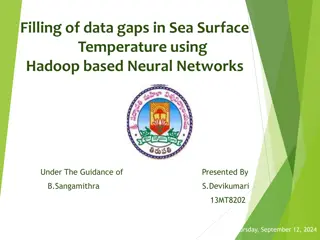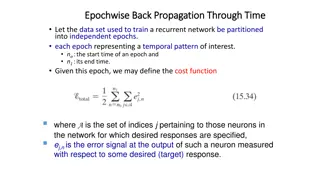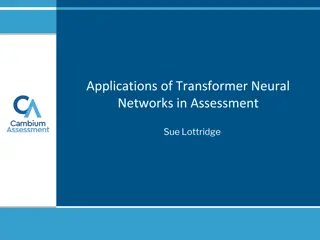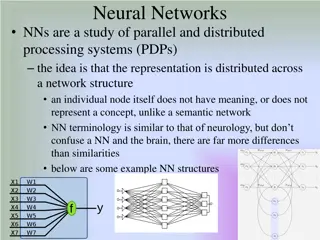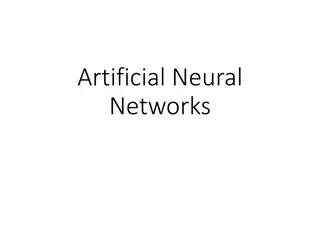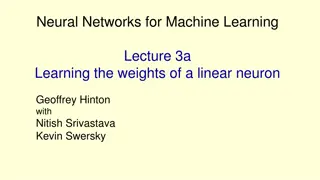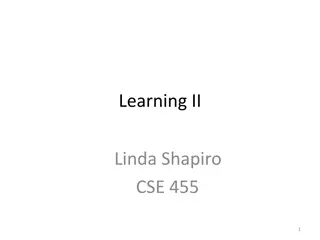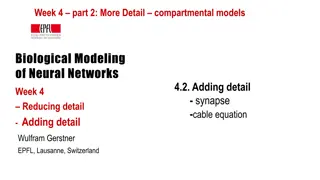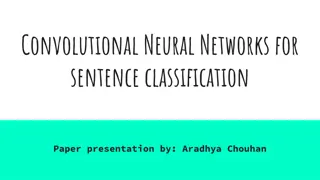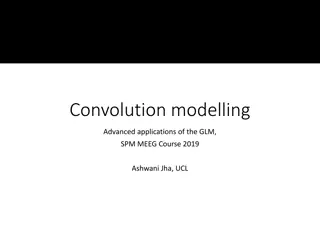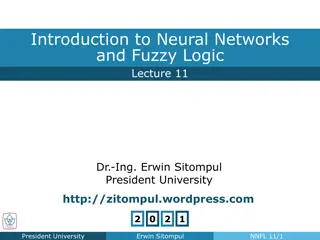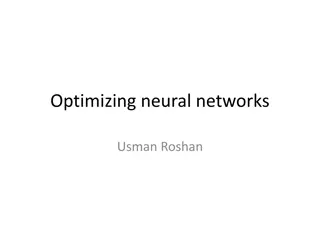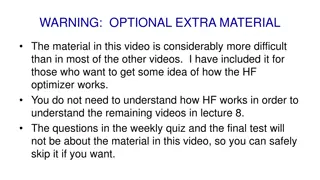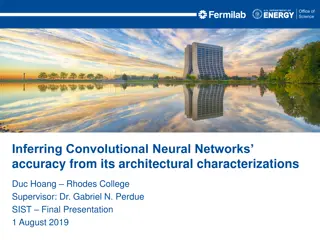Understanding Recurrent Neural Networks: Fundamentals and Applications
Explore the realm of Recurrent Neural Networks (RNNs), including Long Short-Term Memory (LSTM) models and sequence-to-sequence architectures. Delve into backpropagation through time, vanishing/exploding gradients, and the importance of modeling sequences for various applications. Discover why RNNs outperform Multilayer Perceptrons (MLPs) in handling sequential data and how they excel at tasks requiring temporal dependencies.
Download Presentation

Please find below an Image/Link to download the presentation.
The content on the website is provided AS IS for your information and personal use only. It may not be sold, licensed, or shared on other websites without obtaining consent from the author. Download presentation by click this link. If you encounter any issues during the download, it is possible that the publisher has removed the file from their server.
E N D
Presentation Transcript
Recurrent Neural Networks. Long Short-Term Memory. Sequence-to-sequence. Radu Ionescu, Prof. PhD. raducu.ionescu@gmail.com Faculty of Mathematics and Computer Science University of Bucharest
Plan for Today Model Recurrent Neural Networks (RNNs) Learning BackProp Through Time (BPTT) Vanishing / Exploding Gradients LSTMs Sequene-to-sequence
New Topic: RNNs (C) Dhruv Batra Image Credit: Andrej Karpathy
Synonyms Recurrent Neural Networks (RNNs) Recursive Neural Networks General family; think graphs instead of chains Types: Long Short Term Memory (LSTMs) Gated Recurrent Units (GRUs) Algorithms BackProp Through Time (BPTT) BackProp Through Structure (BPTS)
Whats wrong with MLPs? Problem 1: Can t model sequences Fixed-sized Inputs & Outputs No temporal structure Problem 2: Pure feed-forward processing No memory , no feedback Image Credit: Alex Graves, book
Sequences are everywhere Image Credit: Alex Graves and Kevin Gimpel
Even where you might not expect a sequence Image Credit: Vinyals et al.
Even where you might not expect a sequence Input ordering = sequence https://arxiv.org/pdf/1502.04623.pdf Image Credit: Ba et al.; Gregor et al
(C) Dhruv Batra Image Credit: [Pinheiro and Collobert, ICML14]
Why model sequences? Figure Credit: Carlos Guestrin
Why model sequences? Image Credit: Alex Graves
The classic approach Y1= {a, z} Y2= {a, z} Y3= {a, z} Y4= {a, z} Y5= {a, z} X1 = X2 = X3 = X4 = X5 = Hidden Markov Model (HMM) Figure Credit: Carlos Guestrin
How do we model sequences? No input Image Credit: Bengio, Goodfellow, Courville
How do we model sequences? With inputs Image Credit: Bengio, Goodfellow, Courville
How do we model sequences? With inputs and outputs Image Credit: Bengio, Goodfellow, Courville
How do we model sequences? With Neural Nets Image Credit: Alex Graves
How do we model sequences? It s a spectrum Input: No sequence Input: No sequence Input: Sequence Input: Sequence Output: Sequence Output: No sequence Output: Sequence Output: No sequence Example: Im2Caption Example: machine translation, video captioning, video question answering Example: sentence classification, multiple-choice question answering Example: standard classification / regression problems Image Credit: Andrej Karpathy
Things can get arbitrarily complex Image Credit: Herbert Jaeger
Key Ideas Parameter Sharing + Unrolling Keeps numbers of parameters in check Allows arbitrary sequence lengths! Depth Measured in the usual sense of layers Not unrolled timesteps Learning Is tricky even for shallow models due to unrolling
Plan for Today Model Recurrent Neural Networks (RNNs) Learning BackProp Through Time (BPTT) Vanishing / Exploding Gradients LSTMs Sequene-to-sequence
BPTT Image Credit: Richard Socher
BPTT Algorithm: 1. Present a sequence of timesteps of input and output pairs to the network. 2. Unroll the network then calculate and accumulate errors across each timestep. 3. Roll-up the network and update weights. 4. Repeat. In Truncated BPTT, the sequence is processed one timestep at a time and periodically (k1timesteps) the BPTT update is performed back for a fixed number of timesteps (k2timesteps).
Illustration [Pacanu et al] Intuition Error surface of a single hidden unit RNN; High curvature walls Solid lines: standard gradient descent trajectories Dashed lines: gradient rescaled to fix problem
Fix #1 Norm Clipping (pseudo-code) Image Credit: Richard Socher
Fix #2 Smart Initialization and ReLUs [Socher et al 2013] A Simple Way to Initialize Recurrent Networks of Rectified Linear Units [Le et al. 2015] We initialize the recurrent weight matrix to be the identity matrix and biases to be zero. This means that each new hidden state vector is obtained by simply copying the previous hidden vector then adding on the effect of the current inputs and replacing all negative states by zero.
RNN Basic block diagram Image Credit: Christopher Olah (http://colah.github.io/posts/2015-08-Understanding-LSTMs/)
Key Problem Learning long-term dependencies is hard Image Credit: Christopher Olah (http://colah.github.io/posts/2015-08-Understanding-LSTMs/)
Meet LSTMs How about we explicitly encode memory? Image Credit: Christopher Olah (http://colah.github.io/posts/2015-08-Understanding-LSTMs/)
LSTMs Intuition: Memory Cell State / Memory Image Credit: Christopher Olah (http://colah.github.io/posts/2015-08-Understanding-LSTMs/)
LSTMs Intuition: Forget Gate Should we continue to remember this bit of information or not? Image Credit: Christopher Olah (http://colah.github.io/posts/2015-08-Understanding-LSTMs/)
LSTMs Intuition: Input Gate Should we update this bit of information or not? If so, with what? Image Credit: Christopher Olah (http://colah.github.io/posts/2015-08-Understanding-LSTMs/)
LSTMs Intuition: Memory Update Forget that + memorize this Image Credit: Christopher Olah (http://colah.github.io/posts/2015-08-Understanding-LSTMs/)
LSTMs Intuition: Output Gate Should we output this bit of information to deeper layers? Image Credit: Christopher Olah (http://colah.github.io/posts/2015-08-Understanding-LSTMs/)
LSTMs A pretty sophisticated cell Image Credit: Christopher Olah (http://colah.github.io/posts/2015-08-Understanding-LSTMs/)
LSTM Variants #1: Peephole Connections Let gates see the cell state / memory Image Credit: Christopher Olah (http://colah.github.io/posts/2015-08-Understanding-LSTMs/)
LSTM Variants #2: Coupled Gates Only memorize new if forgetting old Image Credit: Christopher Olah (http://colah.github.io/posts/2015-08-Understanding-LSTMs/)
LSTM Variants #3: Gated Recurrent Units Changes: No explicit memory; memory = hidden output Z = memorize new and forget old Image Credit: Christopher Olah (http://colah.github.io/posts/2015-08-Understanding-LSTMs/)
RMSProp Intuition Gradients Direction to Opt Gradients point in the direction of steepest ascent locally Not where we want to go long term Mismatch gradient magnitudes magnitude large = we should travel a small distance magnitude small = we should travel a large distance Image Credit: Geoffrey Hinton
RMSProp Intuition Keep track of previous gradients to get an idea of magnitudes over batch Divide by this accumulate
Sequence to Sequence Learning
Sequence to Sequence Speech recognition http://nlp.stanford.edu/courses/lsa352/
Sequence to Sequence Machine translation Bine a i venit la cursul de nv areprofund Welcome to the deep learning class
Sequence to Sequence Question answering
Statistical Machine Translation Knight and Koehn 2003
Statistical Machine Translation Knight and Koehn 2003
Statistical Machine Translation Components: Translation Model Language Model Decoding
Statistical Machine Translation Translation model Learn the P(f | e) Knight and Koehn 2003
Statistical Machine Translation Translation model Input is segmented into phrases Each phrase is translated into English Phrases are reordered Koehn 2004
Statistical Machine Translation Language Model Goal of the Language Model: Detect good EnglishP(e) Standard Technique: Trigram Model Knight and Koehn 2003
